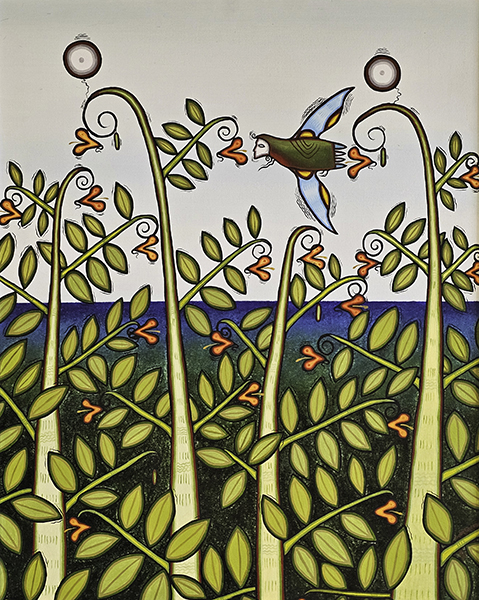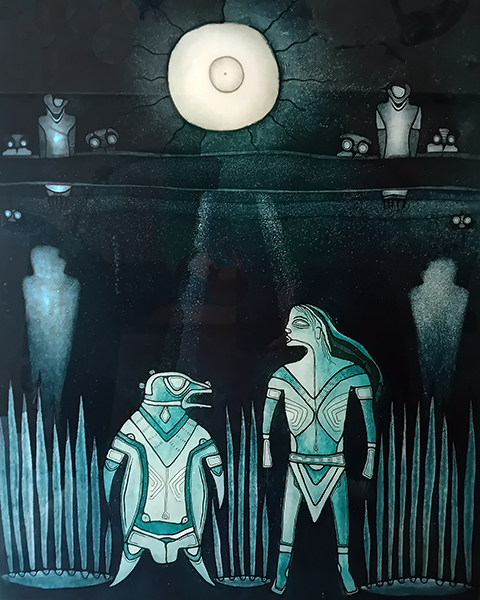Blake Debassige
Blake Debassige (1956-2022) - Artist Biography
Born in 1956 in M'Chigeeng First Nation to Pauline and Chief James David Debassige, Blake Debassige started painting at sixteen and studied briefly at Laurentian University before an influential meeting with artist Carl Ray led him to the Manitou Arts Foundation summer program on Schreiber Island in 1972. It was here that Blake truly blossomed as an artist and it wasn’t even a year before he had his first solo exhibition at the Ontario Institute for Studies in Education in Toronto. Other exhibitions soon followed at the likes of Gallery Phillip, Toronto, Nancy Poole’s Studio, Toronto, the McMichael Canadian Collection, and the Royal Ontario Museum.
A major turning point came in 1985 when Blake, a member of the second generation of important Ojibwe artists who practice the Woodland School including Roy Thomas, Joshim Kakegamic, and Saul Williams, was prominently featured in the seminal Art Gallery of Ontario exhibition – Norval Morrisseau and the Emergence of the Image Makers, curated by Elizabeth McLuhan and Tom Hill.
While Ojibwe legends feature prominently in his pieces, Debassige also championed many pressing political issues through his artwork, such as environmental degradation and Indigenous language preservation. A source of pride for the artist was his successful campaign to have an Anishinaabe painter create a mural to grace the sides of the famous Chi-Cheemaun Ferry which crosses daily between Tobermory on the Bruce Peninsula and South Baymouth, Manitoulin Island, rather than a non-Indigenous artist as was originally planned.
More recently, Blake was featured in the 2017 Royal Ontario Museum exhibition Anishinaabeg: Art and Power, which explored the life, traditions, and sacred stories of the Anishinaabeg as told through their art over the last two centuries. The preservation of Anishinaabeg history and symbolism was very important to Blake and he could be critical of international and modernist sensibilities seeping into Indigenous art practice. The painting entitled Bob Boyer and His Dogs - The Formation of SCANA from 1985, is a tongue-in-cheek reference to the artist's frustration with some of his contemporaries at the time.
Blake Debassige was a true renaissance man – in addition to being a renowned Anishinaabe painter, he was a proud, outspoken figure in his community of M’Chigeeng First Nation, a respected Ojibwe elder, a passionate teacher, a sought-after music aficionado and DJ and a person who did his best to live according to the traditional teachings of his elders.
Key Exhibitions:
The art of the Anishnawbek : three perspectives: exhibition held at the Royal Ontario Museum, 9 March 1996-Spring 1997
Political landscapes: an exhibition of work by thirteen artists from two communities, co-curated by Debassige and Stephen Hogbin and hosted at the Tom Thomson Memorial Art Gallery, August 23-September 22, 1991 and the Ojibway Cultural Foundation and Kasheese Studio, West Bay, Manitoulin Island, Sept. 27-Oct. 20, 1991
Woodlands: Contemporary Art of the Anishnabe, curated by the Thunder Bay Art Gallery July 7-September 3, 1989
Manitoulin Island: The Third Layer, curated by the Thunder Bay Art Gallery April 3-May 24, 1987
Norval Morrisseau and the Emergence of the Image Makers, curated by Elizabeth McLuhan and Tom Hill, Art Gallery of Ontario, Toronto, February 18 - April 15, 1984 (Toronto); Other Ontario centres through 1984 and early 1985
Last Camp, First Song: Indian Art from the Royal Ontario Museum, curated by the Thunder Bay Art Gallery, June 15-July 31, 1983
Anishnabe mee-kun : a circulating exhibition of art by Anishnabe artists of the Manitoulin Island area. Exhibition held at the Ojibwe Cultural Foundation, West Bay, Manitoulin Island, Sept. 15-Oct. 20, 1980
Artist Specialization: Like other woodland artists Debassige's paintings explore the teachings of the Anishnabeg - legends, interdependence, spirituality, but he also investigates current environmental issues and family dysfunction and in that respect has expanded the aesthetic themes of the movement.





